|
|
 |
Fiche d'espèce de Copépode |
|
|
Cyclopoida ( Ordre ) |
|
|
|
Corycaeidae ( Famille ) |
|
|
|
Corycaeus ( Genre ) |
|
|
|
Ditrichocorycaeus ( Sous-Genre ) |
|
|
| |
Corycaeus (Ditrichocorycaeus) erythraeus Cleve, 1904 (F,M) | |
| | | | | | | Syn.: | Corycaeus dubius Farran, 1911 a (p.292, Descr.F, figs.F); M. Dahl, 1912 (p.71, 74, figs.F,M); Wilson, 1942 a (p.180, fig.F); 1950 (p.193); Sewell, 1948 (p.409, 420); Tanaka, 1957 (p.88, figs.F,M); Furuhashi, 1961 a (p.110); Fagetti, 1962 (p.52); De Decker, 1964 (p.15, 21, 27); Tanaka, 1965 a (p.21); Binet & Dessier, 1968 (p.16); Björnberg, 1973 (p.364, 385); Frontier, 1977 a (p.18); Björnberg & al., 1981 (p.676, figs.F,M); Kovalev & Shmeleva, 1982 (p.86); Dessier, 1983 (p.89, Tableau 1, Rem., %); Dessier & Donguy, 1985 (p.1131); Alvarez-Cadena, 1985 (Tab.2); Greze & al., 1985 (p.8); Brinton & al., 1986 (p.228, Table 1); Suarez-Morales & Gasca, 1998 a (p.112); Lavaniegos & Gonzalez-Navarro, 1999 (p.239, Appx.1); Boxshall & Halsey, 2004 (p.495); Ayon & al., 2008 (p.238, Table 4: Peruvian samples); Magris & al., 2011 (p.260, abundance, interannual variability); Tutasi & al., 2011 (p.791, Table 2, abundance distribution vs La Niña event);
Ditrichocorycaeus erythraeus : Boxshall & Halsey, 2004 (p.495); McKinnon & al., 2008 (p.843: Tab.1); Lan Y.-C. & al., 2009 (p.1, Table 2, % vs hydrogaphic conditions); Vives & Shmeleva, 2010 (p.198, figs.F,M, Rem.); Soh & al., 2013 (p.137, figs.F,M) | | | | Ref.: | | | Cleve, 1904 (p.360, 376, Descr.F,M, figs.M); M. Dahl, 1912 (p.52, 74); Gurney, 1927 (p.161, figs.F,M, Rem.); Farran, 1936 a (p.137, Rem.); Sewell, 1948 (p.420, 434); Tanaka, 1960 (p.81, figs.F, Rem.); Delalo, 1968 (p.139); Chen & al., 1974 (p.61, figs.F,M); Kang & al., 1990 (p.52, figs.F, Rem.); Kim & al., 1993 (p.270); Chihara & Murano, 1997 (p.963, Pl.214: F,M); Conway & al., 2003 (p.254, figs.F,M, Rem.); | 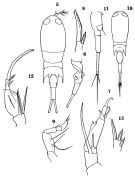 issued from : O. Tanaka in J. Fac. Agricult. Kyushu Univ., 1957, 11 (1). [Pl.7, Figs.5-13]. As Corycaeus (Ditrichocorycaeus) dubius. Female (from Japanese waters): 5, habitus (dorsal); 6, urosome (lateral right side); 7, A2; 8, apical spine of exopod of P2; 9, P4. Nota: Head and 1st thoracic segment separate. The abdominal segments and furca in the proportional lengths 31:33:36 (measured ventrally); another specimen: 29:35:36. Genital segment about 1.3 times as long as wide, with a sharp hook inl ateral view. The sides of the 2nd abdominal segment parallel, about 2.5 times as long as wide. Furcal rami slightly divergent, 10 times as long as wide. Male: 10, habitus (dorsal); 11, urosome (lateral right side); 12, A2; 13, apical spine of exopod of P1. Nota: Posterior corners of 3rd thoracic segment do not extend to the middle of genital segment. The abdominal segments and furca in the proportional lengths 39:26:35.
|
 issued from : Q.-c Chen & S.-z. Zhang & C.-s. Zhu in Studia Marina Sinica, 1974, 9. [Pl.20, Figs.1-9]. Female (from China Seas): 1, habitus (dorsal); 2, corners of the thoracic segments 3 and 4 (dorsal); 3, urosme (lateral left side); 4, A2; 5, terminal spines of exopod of P2; 6, P4. Male: 7, habitus (dorsal); 8, urosome (lateral left side); 9, A2.
|
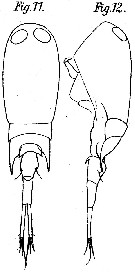 issued from : M. Dahl in Ergebnisse der Plankton-Expedition der Humboldt-Stiftung. Bd II, G. f1. I. Die Corycaeinen 1912. [Taf.X, Figs.11, 12]. As Corycaeus (Ditrichocorycaeus) dubius. Female: 11, habitus (dorsal); 12, idem (lateral left side).
|
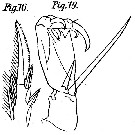 issued from : M. Dahl in Ergebnisse der Plankton-Expedition der Humboldt-Stiftung. Bd II, G. f1. I. Die Corycaeinen 1912. [Taf.X, Figs.16, 19]. As Corycaeus (Ditrichocorycaeus) dubius. Female: 16, P2 (terminal part of exopod); 19, A2.
|
 issued from : M. Dahl in Ergebnisse der Plankton-Expedition der Humboldt-Stiftung. Bd II, G. f1. I. Die Corycaeinen 1912. [Taf.X, Figs.13, 14, 15]. As Corycaeus (Ditrichocorycaeus) dubius. Male: 13, habitus (dorsal); 14, idem (lateral left side); 15, P1 (terminal part of exopod).
|
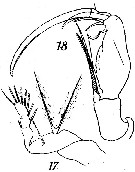 issued from : M. Dahl in Ergebnisse der Plankton-Expedition der Humboldt-Stiftung. Bd II, G. f1. I. Die Corycaeinen 1912. [Taf.X, Figs.17, 18]. As Corycaeus (Ditrichocorycaeus) dubius. Male: 17, P4; 18, A2.
|
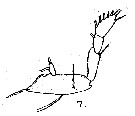 issued from : G.P. Farran in Proc. zool. Soc. Lond., 1911. [Plate XII, Fig.7]. As Corycaeus dubius. Female (from Christmas Island, Indian): 7, P4. Nota: endopodite of P4 small, with 2 setae; exopodite with proportional lengths of its segments approximatively 6:4:5; outer edge seta on 1st segment almost as long as 2nd segment, blunt process on 2nd basal segment internal to endopodite.
|
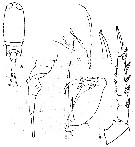 issued from : G.P. Farran in Proc. zool. Soc. Lond., 1911. [Plate XIV, Figs.5-9]. As Corycaeus dubius. Female: 5, habitus (dorsal); 6, urosome (lateral; 7, 3rd and 4th thoracic segments (mounted); 8, A2; 9, exopodite of P2. Nota: Proportions of urosomal segments and caudal rami (dorsally) 21:23:28; ventrally 16:22:27. Sides of cephalon parallel; head + Thh1 being about twice as long as broad. 4th thoracic segment short, with sharp points. Genital segment about 1.1/3 times as long as wide, with setae on genital openings; in lateral view with a small sharp hook anteriorly on ventral edge. Anal segment a little longer than genital segment and slightly overlapped by it dorsally, about 3 times as long as wide. Caudal rami slightly diverging, a little longer than anal segment; rami about 1 x 10. A2 with spine on 1st basal segment very long; spine on 2nd basal segment short, about 1/3 as long as that on 1st basal and falling short of the nearest point of distal margin of segment by about half its own length; distal margin of 2nd basal with 2 shart teeth; terminal spine very strong, shorter than spine on 2nd basal segment.
|
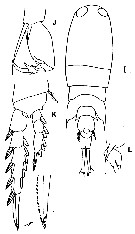 issued from : Y.S. Kang, S.-H. Huh & S.S. Lee in J. Ocanol. Soc. Korea, 1990, 25 (2). [Pl. 2, Figs.I-L]. Female (from Korean waters): I, habitus (dorsal); J, A2; K, P2; L, genital segment (lateral, left side). Nota: Head and 1st thoracic segment separate. Lateral points of 3rd thoracic segment extended to 1/2 the genital segment. Genital segment as long as the anal segment, and with one ventral process. Caudal rami small divergent, 10 times as long as width. Apical spine of exopod of P2 with 2-3 teeth on the inner anterior side. The seta on basipod 1 of A2 approximately 3 times as long as seta on basipod 2 of A2.
|
 [B & H] Female: Anal somite very slender, in dorsal view, 2.5 to 3 times longer than wide. Terminal spine on exopod of P2 with small tooth near base. Short seta on A2 segment reaching beyond distal margin of segment. [V & S] Female: Basipodite 2 of P4 with the 2 setae divergent. Basipodite 2 of A2 with 2 teeth straight and blunt on the inner distal margin. Gental segment plus anal segment longer than caudal rami. Male: Basipodite 2 of A2 with 1 tooth on the inner distal margin. Hook of genital segment , in lateral view, towards behind.
|
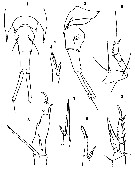 Issued from : O. Tanaka in Spec. Publs. Seto mar. biol. Lab., 10, 1960 [Pl. XXXV]. Female (from 35°09'S, 20°13'E): 1, last thoracic segment and abdomen (dorsal); 2, same (lateral); 3, A2; 4, terminal spine of exopod of P1; 5, P2; 6, terminal spine of exopod of P2; 7, terminal spine of exopod of P3; 8, P5. Nota : Anterior and posterior regions of the body in the proportional lengths 62 to 38. Head separates from the 1st thoracic segment. 3rd thoracic segment produced posteriorly into long spiniform processes, extending to the level of the middle of the genital segment. 4th thoracic segment produced backwardly into sharp spines that direct somewhat outwardly. Proportional lengths of the abdominal segments and caudal rami 32 : 29 : 38 = 100 (dorsal view); 32 : 32 : 36 (ventral view). Genital segment swollen laterally, 1.24 times as long as broad. Lateral margins of the anal segment nearly paralell, 2 times as long as it is broad at the distal end. Caudal rami divergent, 8 times as long it is broad at the proximal. In A2, the spine arising from the 1st basal is more than 3 times as long as that from the 2nd basal segment. In P2, terminal exopodal spine serrated on the inner distal margin, number of serration about 4. Characters male: Cephalothorax and abdomen in the proportional lengths 55 to 45. Abdominal segments and caudal rami in the proportional lengths 41 : 25 : 34 = 100. Ventral hook of the genital segment slender and bent posteriorly.
|
 Issued from : H.Y. Soh, S.Y. Moon & J.H. Wi in Invertebrate Fauna of Korea (eds) Incheon: NIBR, 2013, 21 (28). [p.138, Fig.79]. As Ditrichocorycaeus erythraeus. Female (from Korean waters): A-B, habitus (dorsal,and lateral, respectively); C, urosome (lateral, right side); D, Md; E, Mx1; F, Mxp; G, P5. Scale bars: A, B = 200 µm; C-G = 100 µm.
|
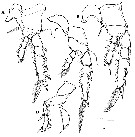 Issued from : H.Y. Soh, S.Y. Moon & J.H. Wi in Invertebrate Fauna of Korea (eds) Incheon: NIBR, 2013, 21 (28). [p.139, Fig.80]. As Ditrichocorycaeus erythraeus. Female: A, P1; B, P2; C, P3; D, P4. Scale bars: 100 µm.
|
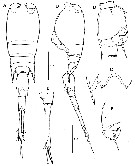 Issued from : H.Y. Soh, S.Y. Moon & J.H. Wi in Invertebrate Fauna of Korea (eds) Incheon: NIBR, 2013, 21 (28). [p.140, Fig.81]. As Ditrichocorycaeus erythraeus. Male: A-B, habitus (dorsal and lateral, respectively); C, Two last thoracic segments (dorsal); D, pedigerous segment 5 and 1st abdominal segment (lateral); E, caudal ramus (lateral); F, P6. Scale bars: A, B = 200 µm; C-F = 100 µm.
|
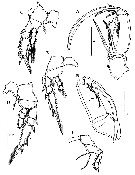 Issued from : H.Y. Soh, S.Y. Moon & J.H. Wi in Invertebrate Fauna of Korea (eds) Incheon: NIBR, 2013, 21 (28). [p.141, Fig.82]. As Ditrichocorycaeus erythraeus. Male: A, A2; B, Mxp; C, P1; D, P2; E, P3; F, P4. Scale bars: 100 µm.
|
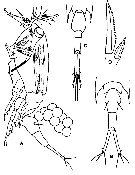 Issued from : R. Gurney in Trans. zool. Soc. London, 1927, 22. [p.162, Fig.23]. Female: A, habitus (lateral) with eggs (from Port Taufiq); B, abdomen (dorsal) (from Suez Bay). Male: C, abdomen (dorsal) (from Ismaïlia); D, apical spine of P2 (from Suez Bay). Nota: A excellent character for determining this species is the presence of 2 (sometimes more) teeth on the inner anterior side of the apical spine of the exopodite of P2. This character mentioned by Farran and stress is laid on it Dahl.
|
 Issued from : R. Gurney in Trans. zool. Soc. London, 1927, 22. [p.162]. Comparative measures between C. erythraeus and C. dubius female and male.
| | | | | Ref. compl.: | | | Othman & al., 1990 (p.561, 564, Table 1); Shih & Young, 1995 (p.76); Park & Choi, 1997 (Appendix); Hsieh & Chiu, 1998 (tab.2); Noda & al., 1998 (p.55, Table 3, occurrence); Ueda & al., 2000 (tab.1); El-Serehy & al., 2001 (p.116, Table 1: abundance vs transect in Suez Canal); Lo & al., 2001 (1139, tab.I); Hsieh & al., 2004 (p.398, tab.1); Rezai & al., 2004 (p.490, tab.2, p.495, tab.8); Lan & al., 2004 (p.332, tab.1); Lo & al., 2004 (p.89, tab.1); Obuid Allah & al., 2005 (p.123, occurrence % vs metal contamination); Hwang & al., 2006 (p.943, tabl. I); Hwang & al., 2007 (p.25); Tseng & al., 2009 (p.327, fig.5, feeding); C.E. Morales & al., 2010 (p.158, Table 1); Fazeli & al., 2010 (p.153, Table 1); Hsiao S.H. & al., 2011 (p.475, Appendix I); Hsiao & al., 2011 (p.317, Table 2, indicator of seasonal change); Kâ & Hwang, 2011 (p.155, Table 3: occurrence %, as erythraea); Tseng L.-C. & al., 2011 (p.47, Table 2, occurrences vs mesh sizes); Johan & al., 2012 (2013) (p.1, Table 1); Tseng & al., 2013 (p.507, seasonal abundance); El-Serehy & al., 2013 (p.2099, Rem.: p.2101); Hwang & al., 2014 (p.43, Appendix A: seasonal abundance) | | | | NZ: | 14 | | |
|
Carte de distribution de Corycaeus (Ditrichocorycaeus) erythraeus par zones géographiques
|
| | | | | | | | | | | | | Loc: | | | South Africa (SE), Patagonia, Brazil (Mucuri estuary), Caribbean Sea, W Medit. (Alboran Sea), Suez Canal: ooccasionally, Port Taufiq, Suez Bay, Safâga, Red Sea, Gulf of Oman, Madagascar (Nosy Bé), Indian, Straits of Malacca, Malaysia (Sarawak: Bintulu coast), Aru Is., Philippines, China Seas (East China Sea, South China Sea), Korea, Taiwan Strait, Taiwan (E, S, W, SW, NW, N, Mienhua Canyon, NE), S Japan (Kuchinoerabu Is.), Korea (W & S), Japan Sea, Japan (Pacific coast), Alaska, off Hawaii, California, Gulf of California, W Mexico (Mazatlan), Australia (Great Barrier, North West Cape, G. of Carpentaria), Galapagos-Ecuador, Peru, Chile (., Concepcion) | | | | N: | 60 | | | | Lg.: | | | (34) F: 1,05-0,96; M: 0,91-0,84; (66) F: 1,03; M: 0,88-0,86; (84) F: 0,93-0,85; (107) F: 1,09; M: 0,836; (109) F: 1,1-0,95; M: 0,87-0,85; (786) F: 1; (991) F: 0,88-1,09; M: 0,83-0,84; (1174) F: 1,12; {F: 0,85-1,12; M: 0,83-0,91} | | | | Rem.: | A la suite de Gurney (1927) et Farran (1936, p.137), Tanaka (1960) confirme l'identité de cette espèce avec Corycaeus dubius, position qui n'est pas toujours suivie par les auteurs postérieurement à cette date. Pour Boxshall & Halsey (2004, p.495) la différence porte sur la longueur de la soie courte du second segment de A2, laquelle n'atteint pas le bord distal du segment chez dubius et dépasse le bord distal chez erythraeus, mais une différence apparaît ente les A2 female et male sur la longueur de cette soie.
Voir aussi les remarques en anglais | | | Dernière mise à jour : 04/12/2020 | |
|
|
 Toute utilisation de ce site pour une publication sera mentionnée avec la référence suivante : Toute utilisation de ce site pour une publication sera mentionnée avec la référence suivante :
Razouls C., Desreumaux N., Kouwenberg J. et de Bovée F., 2005-2025. - Biodiversité des Copépodes planctoniques marins (morphologie, répartition géographique et données biologiques). Sorbonne Université, CNRS. Disponible sur http://copepodes.obs-banyuls.fr [Accédé le 16 août 2025] © copyright 2005-2025 Sorbonne Université, CNRS
|
|
 |
 |


















